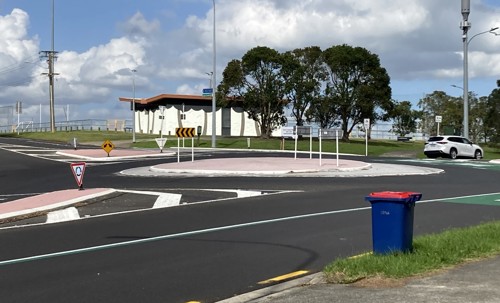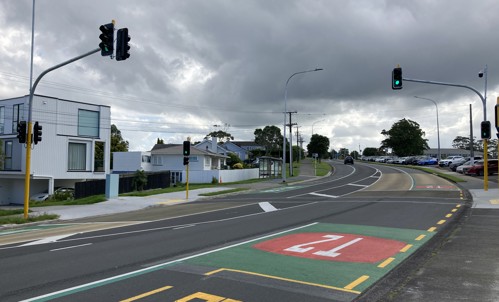Bus lane for East Coast Road Bus lane for East Coast Road
From 2023 to 2024, Auckland Transport (AT) in partnership with Waka Kotahi made key changes to East Coast Road in Forrest Hill that will provide people with more transport options and make it easier, safer, and more affordable to travel in ways that are good for all of us and the environment.
Project status: Completed
Project zone: North
Project overview
These improvements are part of the Climate Emergency Response Fund’s Transport Choices Package, which prioritizes infrastructure investments that reduce reliance on cars and provide people with more sustainable transport options. They will help reduce bus travel times along the East Coast Rd corridor, improve bus shelters and stops, and allow the buses to better share the road with motorists and cyclists – creating a safer, better, and more reliable public transport system.

A section of the completed T2 bus lane along East Coast Road.
The improvements included:
- Removal and construction of a new roundabout at the Forrest Hill Road / East Coast Road junction.
- Improvements to the traffic islands at the Forrest Hill Road / East Coast Road junction.
- Construction of speed tables at each approach to the roundabout.
- Signalised pedestrian crossings near William Souter Street and Sunnynook Road. This includes the associated ducting, civil and concrete works.
- Pavement construction and surfacing along the length of the project.
- Kerb, footpath, and driveway construction at various locations along the length of the project.
- New bus shelters and furniture.
- New road marking and signage to facilitate the new bus lane.
Construction

The new roundabout at the Forrest Hill Road / East Coast Road junction.
Auckland Transport engaged Fulton Hogan to complete construction of this project.
Construction updates:
July: Construction crews finished most of the enabling works, including drainage, ducting, and concrete works, on the western side of the construction zone.
August: Crews completed remaining enabling works for the eastern side of the construction zone and have commenced with kerb buildout, surfacing, and signage installation. They also began laying down footpaths, crossings, and channelling and drainage works at the northwest and southwest sides of the construction zone.
September: Construction crews completed drainage works, channelling, kerb layouts, and laying down footpaths on the southwestern side of the construction zone. They also began surfacing works for the new bus lane, prep works for the new signalised crossings at William Souter Street, and constructing the new roundabout and speed tables at the Forrest Hill Road / East Coast Road junction.
October: Construction crews finished installing the new roundabout and speed tables at the Forrest Hill Road / East Coast Road intersection, along with new road markings and signage. They also began constructing the new bus pad and shelter near 310 East Coast Road as well as upgrading the nearby footpaths.
November 2023 to February 2024: Between November 2023 and February 2024, construction crews finished most of the major works. These included relocating one of the bus stops on East Coast Road (near Sunnynook Road) slightly further up the road, adding a new bus shelter and footpath, installing new signalised pedestrian crossings, and road resurfacing and line-marking works.
March to April 2024: Crews finished installing all the communications and lighting systems to fully activate the last of the signalised crossings. All remaining works were completed at the end of April.


Images of one the recently commissioned signalised pedestrian crossing at East Coast Road.
Project details
East Coast Road and Raleigh Road on the North Shore were prioritised for improvements under Waka Kotahi’s Transport Choices programme to create two sections of bus priority to improve travel time and reliability. This included pedestrian crossings and other safety improvements.

One of the new signalised pedestrian crossings on East Coast Road.
What is the Transport Choices Package?
Our current ways of living are harming the environment, our communities, and our ways of moving around. We see this every day with extreme weather events, unhealthy environments, and increased cost of living. No matter where we are, we should be able to move easily around our city in ways that help us to protect our climate. We need to transition to a low-emissions and climate-resilient future for the benefit of all New Zealanders and future generations.
Transport Choices aims to demonstrate what’s possible for communities across Aotearoa New Zealand by quickly providing people with more transport options and making it easier and more affordable to travel in ways that are good for all of us and our environment.
Transport Choices an investment package for local councils to begin immediate work for reduction of emissions, as part of the emissions reduction plan released in May 2022. Its purpose is to build momentum, capability, and public support ahead of more detailed VKT reduction planning and investment programmes that will happen over the next few years.
Greater transport choices mean a safer, healthier environment for communities across Aotearoa New Zealand.
What does Transport Choices focus on?
Transport Choices investments are targeted in four key areas:
- making public transport more reliable and easier to use
- creating walkable neighbourhoods
- progressing strategic cycle networks
- safe, green, and healthy school travel.

An upgraded bus shelter along East Coast Road.
The Government has funded $350 million for the Transport Choices package from the Climate Emergency Response Fund, part of Budget 2022.
Learn more about the Transport Choices programme.
Learn more about the Climate Emergency Response Fund (CERF) programme.
Original proposal and public feedback
In August 2020, we asked for feedback on plans to make improvements to East Coast Road in Forrest Hill. The below sections provide full details of the proposed improvements. The proposal was open for public feedback from 10 August to 30 August 2020.
Proposed bus lane
- Install a northbound bus lane on East Coast Road, between the East Coast Road/Forest Hill Road roundabout and 310 East Coast Road:
- Length of 710m
- Hours of operation will be 24 hours, 7 days a week.
- The space for the bus lane will be achieved by narrowing the painted central median, narrowing the existing T2 lane on the northern side of East Coast Road to 3.5m, and adjusting the kerb in some locations. The creation of the bus lane does not require parking removal.
- Buses, bicycles, and motorbikes will be permitted to use the bus lane. For people on bikes this will provide a more attractive on road cycle route, than sharing a general traffic lane.
Proposed changes to the Forest Hill Road roundabout
- Amend the left-turn only lane from East Coast Road into Forest Hill Road, to allow buses to turn right into the northbound section of East Coast Road.
- Create a section of bus lane around the south and western edges of the roundabout. Space for the bus lane will be created by narrowing the central roundabout island. The bus lane would operate 24 hours seven days a week, to avoid confusion to bus drivers and other road users.
- Install Swedish style raised tables on all three approaches to the intersection to slow vehicle speeds and improve safety. A Swedish style table has been chosen as it provides a smoother transition for buses and other vehicles, while still being effective at reducing vehicle speeds.
- Reconfigure the central raised traffic islands on the southern legs of the Forest Hill Road/East Coast Road roundabout.
Proposed changes to bus stops and shelters
- Relocate the existing bus stop and shelter on the northern side of East Coast Road (opposite 312 East Coast Road) to the southeast side of the vehicle exit from Pupuke Golf Club (opposite 306/308 East Coast Road). This will mean that the bus stop is located closer to the proposed pedestrian crossing and that buses coming from Sunnynook Road can also use this bus stop.
- Relocate the existing bus stop and shelter on the eastern side of East Coast Road, from opposite 252 East Coast Road to opposite 256/258 East Coast Road. This will ensure buses parked at the bus stop won’t obstruct other vehicles views of people using the pedestrian crossing.
- Install a new shelter at the existing bus stop outside 312 East Coast Road.
- Relocate the existing bus stop and shelter on the northern side of East Coast Road, which is in front of the Pupuke Golf Club car park (opposite 282 east Coast Road), to opposite 276 East Coast Road (just north of the William Souter Street intersection). This will improve the spacing of bus stops and also mean the bus stop is closer to the proposed signalised pedestrian crossing.
- Widen the footpath at the bus shelter outside 246/248 East Coast Road and widen the driveway access to 248, 248A, and 250 East Coast Road. This will provide space for passengers to enter and exit the bus without obstructing the shared pedestrian/bicycle path.
- Relocate the existing bus stop and shelter on the western side of East Coast Road, from 278 East Coast Road to 280 East Coast Road. This will allow a full-length bus stop to be installed, as space at the current bus stop location is constrained by the proposed signalised pedestrian crossing and driveways.
Proposed changes to the exit from the East Coast Road/Sunnynook Road roundabout
- Traffic turning right from Sunnynook Road onto East Coast Road currently merges with the southbound bypass lane near the proposed signalised pedestrian crossing, it is proposed that the two southbound lanes be extended to the start of the existing T3 lane.
Proposed signalised pedestrian crossings
- Three new signalised pedestrian crossings, outside 252, 278 and 308 East Coast Road.
Proposed driveway reconstruction
- Reconstruct the driveway accesses to 248, 248A, and 250 East Coast Road as part of the bus stop improvements (kerb relocation) outside 248 East Coast Road.
Proposed changes to the painted central median
- The painted median will be removed along East Coast Road from Forest Hill Road to Sunnynook Road to provide space for the bus lane and dual traffic lane extension.
- However, the central median and right-turn bay at William Souter Street will largely be retained.
Parking removal
- There is parking removal on the northern/eastern side of East Coast Road at the following locations:
- Opposite 302-306, 296, 276-280 and 256-260 (due to bus stop relocations and to ensure buses can easily pull up against the kerb at the bus stops and exit bus stops easily).
- Opposite 296 (to prevent vehicles parking at the entrance to the T2 lane).
- There is plenty of capacity in the on-street parking immediately next to, or near, all the parking removal locations to accommodate parking demand.
After considering all the feedback, we have decided to progress the project through to implementation, subject to the following change:
- Slightly move the signalised pedestrian crossing that was proposed outside 278 East Coast Road so that it does not conflict with the new vehicle crossing in that location.
Download the updated drawing for this proposal (PDF 1.8MB)
Outcome
The proposal for improvements to East Coast Rd was open for public feedback from 10 August to 30 August 2020. In total, 21 submissions were received.
Read the main points made by submitters and AT’s response to these points in the feedback document (PDF 125KB).
After considering all the feedback, we have decided to progress the project through to implementation, subject to the following change:
- Slightly move the signalised pedestrian crossing that was proposed outside 278 East Coast Road so that it does not conflict with the new vehicle crossing in that location.
Download the updated drawing for this proposal (PDF 1.8MB)